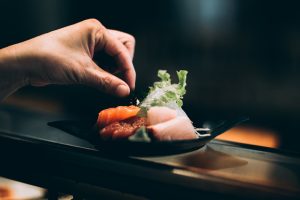Discovering Terakawa Ramen: A Culinary Delight
Terakawa Ramen has a rich and fascinating history that dates back to the early 20th century in Japan. The origins of this beloved dish can be traced back to the city of Kumamoto, located on the island of Kyushu. It was here that the first bowl of Terakawa Ramen was created by a visionary chef who sought to combine traditional Japanese flavors with a unique twist. The name “Terakawa” itself holds significance, as it refers to the Terakawa River that runs through the city of Kumamoto, where the dish originated.
The story goes that the chef, inspired by the local ingredients and culinary traditions of Kumamoto, set out to create a new type of ramen that would capture the essence of the region. He experimented with different combinations of broth, noodles, and toppings, eventually settling on a recipe that would become the signature flavor of Terakawa Ramen. Over time, the dish gained popularity not only in Kumamoto but also throughout Japan, and eventually, it made its way to other parts of the world. Today, Terakawa Ramen is celebrated for its rich history and unique flavor profile, making it a beloved dish for ramen enthusiasts around the globe.
The Unique Flavors of Terakawa Ramen: Exploring the Ingredients
One of the key elements that sets Terakawa Ramen apart from other types of ramen is its unique flavor profile, which is achieved through a carefully curated selection of ingredients. The broth, for example, is made using a combination of pork bones, chicken bones, and a special blend of seasonings that give it a rich and savory taste. This flavorful broth is then paired with thin, straight noodles that are cooked to perfection, creating a satisfying texture that complements the broth beautifully.
In addition to the broth and noodles, Terakawa Ramen is typically topped with an array of mouthwatering ingredients that add depth and complexity to the dish. This may include tender slices of chashu pork, marinated bamboo shoots, a perfectly cooked soft-boiled egg, and a sprinkling of green onions. Each component is carefully chosen to enhance the overall flavor profile of the dish, creating a harmonious blend of savory, salty, and umami notes that tantalize the taste buds. It’s this careful attention to detail and commitment to quality ingredients that make Terakawa Ramen a truly exceptional culinary experience.
Key Takeaways
- Terakawa Ramen originated in Fukuoka, Japan, and has a rich history dating back to the 1950s.
- The unique flavors of Terakawa Ramen come from its special ingredients such as tonkotsu broth, thin noodles, and toppings like chashu pork and green onions.
- Making Terakawa Ramen involves a meticulous process of simmering pork bones for hours to create a rich and creamy broth, and carefully assembling the dish with the perfect balance of flavors.
- Terakawa Ramen offers a culinary experience that reflects the depth of Japanese culture and tradition, with its emphasis on quality ingredients and precise preparation techniques.
- Despite its indulgent flavors, Terakawa Ramen can also be a nourishing and healthy meal, providing a good source of protein, vitamins, and minerals.
- Terakawa Ramen has gained popularity worldwide, with variations and adaptations in different countries, showcasing its global appeal and versatility.
- Enjoying Terakawa Ramen at home can be a delightful experience with the right recipes and tips for creating authentic flavors and textures.
The Art of Making Terakawa Ramen: A Step-by-Step Guide
Crafting a bowl of authentic Terakawa Ramen is a labor of love that requires precision, patience, and a deep understanding of traditional Japanese cooking techniques. The process begins with the preparation of the broth, which involves simmering pork bones and chicken bones for several hours to extract their rich flavors. This is then combined with a carefully balanced blend of seasonings, such as soy sauce, mirin, and sake, to create a complex and aromatic base for the ramen.
While the broth simmers, the noodles are prepared separately, using a specific type of wheat flour and alkaline water to achieve the perfect texture and chewiness. Once cooked, the noodles are rinsed and drained before being added to the bowl. The toppings are then meticulously arranged on top, with each component placed thoughtfully to create an aesthetically pleasing presentation.
Finally, the piping hot broth is carefully ladled over the noodles and toppings, infusing the entire bowl with its rich aroma and flavor. The result is a masterpiece of culinary artistry that showcases the skill and dedication of the chef behind it. From the first steaming spoonful to the last satisfying slurp, every aspect of Terakawa Ramen reflects the time-honored traditions and meticulous attention to detail that define Japanese cuisine.
Terakawa Ramen: A Culinary Experience in Japanese Culture
Terakawa Ramen is more than just a delicious dish; it’s a culinary experience that offers a window into Japanese culture and tradition. From its humble origins in Kumamoto to its widespread popularity today, Terakawa Ramen embodies the spirit of innovation and craftsmanship that defines Japanese cuisine. The careful selection of ingredients, meticulous preparation techniques, and emphasis on balance and harmony all reflect the core principles of Japanese culinary artistry.
In addition to its culinary significance, Terakawa Ramen also holds cultural importance as a beloved comfort food that brings people together. Whether enjoyed at a bustling ramen shop in Tokyo or prepared at home with loved ones, Terakawa Ramen has a way of fostering connection and community. It’s a dish that transcends borders and language barriers, uniting people from all walks of life in their shared love for its rich flavors and satisfying warmth.
Furthermore, Terakawa Ramen has become an integral part of Japanese pop culture, appearing in films, television shows, and literature as a symbol of comfort, nourishment, and tradition. Its enduring popularity both in Japan and around the world speaks to its timeless appeal and its ability to capture the hearts and taste buds of food enthusiasts everywhere.
Health Benefits of Terakawa Ramen: Nourishing and Delicious
| Health Benefits of Terakawa Ramen: Nourishing and Delicious |
|---|
| 1. Rich in Protein |
| 2. Contains Essential Vitamins and Minerals |
| 3. Provides Sustained Energy |
| 4. Supports Muscle Recovery |
| 5. Promotes Hydration |
While Terakawa Ramen is undoubtedly indulgent and flavorful, it also offers a range of health benefits that make it a nourishing choice for those seeking a satisfying meal. The broth, for example, is rich in collagen and gelatin, which are known for their potential benefits for joint health and skin elasticity. Additionally, the combination of protein from the pork or chicken in the broth and carbohydrates from the noodles provides a balanced source of energy that can help sustain you throughout the day.
Furthermore, many of the toppings commonly found in Terakawa Ramen, such as bamboo shoots and green onions, offer valuable nutrients like fiber, vitamins, and antioxidants. These ingredients not only contribute to the overall flavor profile of the dish but also provide essential elements for maintaining overall health and well-being.
It’s important to note that while Terakawa Ramen can be a nutritious choice when enjoyed in moderation as part of a balanced diet, it’s also high in sodium and should be consumed mindfully. By savoring each spoonful and being mindful of portion sizes, you can fully appreciate the nourishing qualities of Terakawa Ramen while still maintaining a healthy lifestyle.
Terakawa Ramen Around the World: Global Popularity and Variations
In recent years, Terakawa Ramen has gained widespread popularity beyond its native Japan, making its way onto menus in cities around the world. From New York City to London to Sydney, ramen enthusiasts have embraced this beloved dish for its rich flavors and comforting appeal. As a result, many chefs outside of Japan have put their own unique spin on Terakawa Ramen, incorporating local ingredients and culinary influences to create exciting variations on the classic dish.
For example, in New York City’s vibrant food scene, you might find Terakawa Ramen topped with locally sourced vegetables or artisanal meats, adding a touch of creativity and innovation to the traditional recipe. In London, chefs may experiment with different types of noodles or seasonings to put their own stamp on this beloved dish. These global variations not only showcase the adaptability of Terakawa Ramen but also celebrate the diversity of culinary traditions around the world.
Despite these creative interpretations, one thing remains constant: the enduring appeal of Terakawa Ramen as a comforting and satisfying meal that transcends cultural boundaries. Whether enjoyed in its traditional form in Japan or savored in a new incarnation abroad, Terakawa Ramen continues to captivate food lovers everywhere with its rich history and irresistible flavors.
How to Enjoy Terakawa Ramen at Home: Recipes and Tips for Homemade Delight

For those who want to experience the joy of Terakawa Ramen in the comfort of their own kitchen, there are plenty of resources available to help you recreate this iconic dish at home. Many cookbooks and online tutorials offer step-by-step instructions for making authentic Terakawa Ramen from scratch, guiding you through each stage of preparation with clear explanations and helpful tips.
When making Terakawa Ramen at home, it’s important to pay close attention to each component of the dish, from the broth to the noodles to the toppings. Taking your time to source high-quality ingredients and follow traditional techniques will ensure that your homemade ramen captures the essence of this beloved dish.
Additionally, don’t be afraid to get creative with your toppings or seasonings to personalize your bowl of Terakawa Ramen to your liking. Whether you prefer extra slices of chashu pork or a sprinkle of spicy chili oil, making your own homemade ramen allows you to tailor the dish to your taste preferences.
By embracing the artistry and tradition behind Terakawa Ramen while adding your own personal touch, you can create a truly memorable dining experience that celebrates Japanese culinary heritage while reflecting your own unique flair. Whether enjoyed at home or shared with friends and family, homemade Terakawa Ramen is sure to delight all who have the pleasure of savoring its rich flavors and comforting warmth.
If you’re a fan of Terakawa Ramen, you’ll love this article on the best ramen spots in New York City. Check out Among Old Friends for a comprehensive guide to the top ramen restaurants in the Big Apple, including Terakawa Ramen. Whether you’re a ramen connoisseur or just looking for a delicious bowl of noodles, this article has got you covered.
FAQs
What is Terakawa Ramen?
Terakawa Ramen is a type of Japanese noodle soup dish that originated in the Kyushu region of Japan. It is known for its rich and flavorful pork-based broth, chewy ramen noodles, and various toppings such as chashu pork, bamboo shoots, and green onions.
What are the main ingredients in Terakawa Ramen?
The main ingredients in Terakawa Ramen include pork bones, water, ramen noodles, chashu pork (braised pork belly), bamboo shoots, green onions, and various seasonings such as soy sauce, miso, or salt.
What is the flavor profile of Terakawa Ramen?
Terakawa Ramen is known for its rich and savory flavor profile, with a deep umami taste from the pork-based broth. The noodles are chewy and the toppings add texture and additional flavors to the dish.
Is Terakawa Ramen spicy?
Terakawa Ramen can be customized to be spicy by adding chili oil or other spicy condiments. However, the traditional version of Terakawa Ramen is not inherently spicy.
What are the different variations of Terakawa Ramen?
There are several variations of Terakawa Ramen, including tonkotsu (pork bone broth) ramen, miso ramen, and shoyu (soy sauce) ramen. Each variation has its own unique flavor profile and ingredients.
Is Terakawa Ramen gluten-free?
Traditional Terakawa Ramen is not gluten-free, as the noodles are made from wheat flour. However, there are gluten-free ramen noodle options available for those with dietary restrictions.














Post Comment
You must be logged in to post a comment.